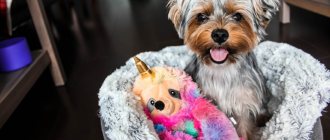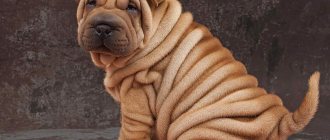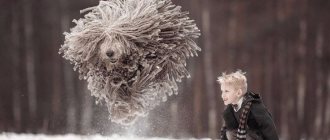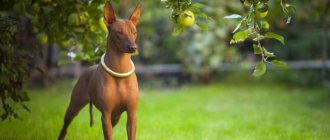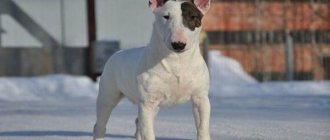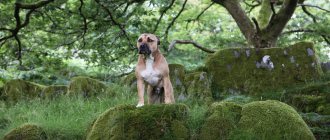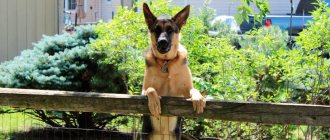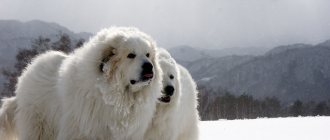History of the origin of the African dog
The history of the Basenji is still a mystery to modern researchers, because these cute hunting dogs are no less than 5,000 years old. And although their homeland is considered mainly to be the Central African region, in the epicenter of which the state of Congo is located, portraits and sculptural figurines of dogs very similar to Basenji, as well as their mummies, are still discovered by archaeologists quite far from Congo, in the burial places of pharaohs and priests Ancient Egypt. And this is not surprising; historians and Egyptologists know that Congolese dogs were brought to Egypt not only for hunting, but also as amulets as gifts for the nobility.
However, the historical African homeland of the animal still declares itself through the existing abundance of breed names that geographically indicate the origin of the Basenji. These are: “bush Congo dog”; "Congo Terrier"; "Congolese terrier" and "forest dog from the Congo". In addition to these names, Basenji dogs are often called “Bongo” or “Zande dogs” (after the name of the Central African people living in the Congo, the Central African Republic and Sudan). Or even much more sonorous and even funny-exotic - “nyam-nyam terrier.” And in a very native way - “jumping up and down” (“Mbwa Mkubwa Mbwa”).
However, despite such an abundance of names, no one knows the true origin of the handsome Basenji. The first European to become acquainted with the hunting dogs of the Sande tribes was the famous German traveler and explorer Georg August Schweinfurth. Traveling in 1863–1866 with ivory buyers through the territory of South Sudan and the Congo, he noticed a large number of wooden figurines of dogs hanging above the huts, as well as the unusually silent dogs themselves with bells around their necks. As the natives explained to the traveler, the bells were needed in order not to lose this incredibly valuable “silent dog” in the tall grass of the savannah. Schweinfurt called the discovered dogs "Congolese terriers", fully describing their appearance in his diary.
The next European to personally become acquainted with the Basenji was the English traveler and explorer of Africa Sir Harry Hamilton Johnston. During an expedition along the Congo River in 1882, he, like Schweinfurt, discovered unexpectedly silent dogs among local tribes. Being also a talented photographer and artist, he not only described the exterior of his find in his diary, but also took a number of photographs and sketches, subsequently exhibiting them at the Royal Academy of Arts in London. This is how residents of Great Britain and other countries were able to see Basenji dogs for the first time in all their pristine glory.
In 1895, the first pair of Basenji dogs set foot on the shores of Foggy Albion. They were brought by Briton James Garrow. True, these dogs survived the long sea voyage rather poorly, and soon died of distemper. All further attempts to adapt the brought Basenjis to the climatic conditions of Great Britain also ended unsuccessfully. These animals were completely unsuited to the damp, cold climate of the British Isles, as well as a number of local canine diseases to which they had no immunity. But in the zoos of Germany and France (where they were brought in 1905 as exotic animals of Africa), Basenjis felt surprisingly well.
And only in the 30s of the 20th century, the English pioneer breeders of African Congo Terriers finally managed to overcome all the difficulties of adaptation of animals, their strange intolerance to vaccinations, and began breeding Basenjis in Great Britain.
In 1937, thanks to the many years of efforts of dog breeder Olivia Burn, the Basenji breed was officially included in the British Stud Book. That same year, unusual silent dogs were presented by Olivia Barn at the Kraft exhibition, causing considerable excitement among the public who wanted to see for themselves that the “jungle dog” did not actually bark.
After such a surge in interest, the new breed also became interested in Americans. And soon (approximately in the same 1937) Congo terriers were brought to the USA, and in 1942 they were registered with the American Kennel Club (AKC).
In 1939, the first Basenji club was created in Great Britain. In subsequent years, the Second World War prevented the further development and spread of the breed in Great Britain. But by 1947, Congolese terriers had not only restored their former positions, but also gained world championship titles. And they were even presented to King Farokh of Egypt (at that time Egypt was still a monarchy) during a visit to Great Britain as a gift. The dog, which for many millennia was previously the “guardian of the pharaohs,” has again returned to its ancient duties in relation to the Egyptian monarchs.
In 1964, the Congolese Bush Dog was recognized by the Fédération Cynologique Internationale, taking its place in the group of Spitz and primitive dogs.
Colors
Let's take a closer look at what the above colors represent.
Black and white
This is a strict, elegant classic. Black color is shiny and has no impurities or shades. It is not covered by red, as is the case with Fula Black.
The black color is more of a pattern than a separate type of color. Breed standards do not distinguish between black and black and white Basenjis, but do require a pure black color without shades.
At first glance, it is no different from the black and white suit, but in fact it is not so. “Fula Black” is characterized by silty shades, which only becomes evident over time. This color is especially distinguished by the burning red tint, which is visible when light hits the coat. True, black representatives of this breed are rare.
Tricolor
A dog with this color combines three colors - black, white and red-red. The gene responsible for this combination of colors is recessive and therefore does not appear so often. A dog with this color is essentially black and tan - they are present on the face, slightly along the edges of the chest, but they can also appear in a larger volume.
brindle
This coloring is characterized by a red base and black stripes. The clearer the outline of these stripes, the better. These dogs are very exotic in appearance, their color resembles marble. The background color can vary from red to lighter tones.
It is worth noting that this color was recognized only in 2000 in Australia, Great Britain and other countries that are part of the FCI. That is, tiger Basenjis can take part in exhibitions only in these countries.
Red and white
It is also called red. Bright, sunny color of the main color without any impurities. It is also unacceptable to go into a creamy shade - the base color must be uniform.
ATTENTION! Individuals with a base cream color are considered defective and are excluded from the breeding process.
Appearance
The Basenji is a small dog, graceful in build, elegant and full of grace, which in its appearance resembles a gazelle. It has a proportionally built body, a straight back, a moderately wide and deep chest with clearly defined ribs, its short lumbar region and lower line merge into a noticeable waist. The tail is curled tightly over the coccyx and fits tightly to the thigh with a single or double whorl.
The head is raised high and sits on a long, beautifully arching neck. The skull is flat, of medium width, tapering from the eyes to the nose. The foot is small. The eyes are almond-shaped, located slightly obliquely, framed by a dark eyelid. The ears are set high, small, erect, slightly tilted forward. Nose is black. The jaw and mouth are powerful, with an ideal, uniform and complete scissor bite, that is, the lower row of teeth fits tightly to the upper one, the teeth themselves in both rows grow vertically.
The forelimbs are straight, with thin bone. The shoulder blades are very muscular, the elbows are adjacent to the chest. The hind legs are powerful and very strong, moderately muscular, the hock joints are low, turning neither in nor out. The feet are small, narrow, closed, with thick pads, noticeably arched toes and short nails.
The Basenji has two characteristics that set it apart from other dogs: wrinkles on the forehead and a characteristic curled tail. It's hard to believe that these dogs have so much skin at birth - they even look a little like a Shar Pei. Over time, the skin smoothes out, however, areas with slightly saggy skin and a wrinkled forehead remain for the rest of your life. In puppies, the tail is straight and, as the animal grows, it gradually curls and fits in a characteristic way on the hip.
Coat and color
The Basenji has very elastic skin and a short, smooth, close-fitting and very delicate coat.
Basenji dogs come in different colors:
- Pure black and white;
- Red and white;
- Black, burning color with white, dark spots above the eyes - “melon seeds”, as well as on the muzzle and cheeks;
- Black, burning bright, with white;
- Striped: black stripes on a red background; The clearer the stripes, the better.
An interesting fact is that the last coloration was recorded by the FCI only in 2001. The following are still awaiting recognition: striped tricolor, trindle, sable, marbled, cream, light white on red, tricolor on red, tricolor saddle.
A special feature of the Basenji is the presence of white spots. White markings should be present on the paws, chest and tip of the tail. White paws, arrow and collar are optional. It turns out that the white collar around the neck, so appreciated at exhibitions, is also not mandatory. In litters, depending on the color of the parents, puppies with different colors may be born.
Basenjis are unusually clean dogs that wash themselves just like cats. Most often, they themselves tidy up their short hair, which also does not have a dog smell. It does not take much time to care for it; usually, it is enough to comb it with a brush.
Breed standard
Basenjis are beautifully built, active dogs that cannot sit in one place for a long time. Such a dog often emerges victorious in sports competitions and looks great at exhibitions, all because of its well-developed muscles and beautiful appearance. The weight of adults is 9-11 kg , with a height of 40-43 cm .
An elegant head proudly rests on a strong, long neck with a graceful curve. The scruff is well defined. The ears are small, erect, pointed and slightly tilted forward. When the Basenji is excited and pricks up its ears, abundant wrinkles appear on its forehead. This is one of the characteristics of the breed, which is especially evident in small puppies. Dark eyes with an oblique cut, almond-shaped. The nose is black. The jaws are powerful and have a scissor bite.
The back is straight and short. The chest is deep, the stomach is tucked. The limbs are straight, muscular with thin bones. The shins are long. The paws are neat, small in size, with deep pads. The tail is set high, tightly curled into a ring (single or double). It is another feature of the Basenji breed.
The coat is short and smooth. The guard hair is very thin. Such wool cannot save a dog from the cold. According to the standard, the following colors are allowed:
1. Tricolor (black with red-red). 2. Black and white. 3. Tiger. 4. Red and white.
Regardless of color, it is not permissible for white to predominate.
Based on their appearance, Basenjis are divided into two types:
1. Plains Basenji - long limbs, height about 40 cm. The color is lighter than the color of the forest Basenji. There is a white "collar" that extends to the chest and covers the legs in the form of white "pants". 2. Forest Basenji - inferior in size to the plain species, height at the withers is less than 40 cm. The color is dark. Due to its relatively small size, the forest Basenji is called the “pygmy dog.”
Character of the Basenji. Who is the breed suitable for?
The Basenji's character is cheerful and cheerful. Playful, active puppies are quite difficult to control, but from the age of three months it is time to start training, otherwise with age it will become increasingly difficult to achieve obedience. It is even more difficult to achieve if you do not walk a dog whose energy flows over the edges. Count on the fact that Basenjis love movement and need an equally active owner. He may not be a professional athlete, but he must have free time to go for a walk and be able to throw a stick far. Well, or let the family have older children who are ready to physically exhaust the dog. The Basenji dog is not aggressive and will treat small children in the family well, but it is better to control the interaction between an animal of any breed and a child.
Basenjis treat strangers with obvious distrust, and will keep an eye on guests who come to the house. At the same time, they are affectionate to their owners and will welcome permanent family friends. These dogs are not aggressive and will not once again distract the owners with annoying barking at every rustle, but they will definitely direct their minds to pranks and will be noisier if the owners do not bother to walk them. Most of all, Basenjis love to walk and run, however, since the breed is a hunting breed, it is better to learn to control the dog so that it would prefer to respond to the owner’s call rather than run after a squirrel in the park.
Dog Temperament
The Basenji will become an obedient and friendly pet if you find the right approach to it:
- To achieve success in raising and training a dog, find the right motivation for it. Keep your workouts short, fun, and active.
- Keep in mind that the African dog chooses only one owner, to whom he becomes attached with all his soul.
- To ensure that the Basenji meets your guest without incident, ask your friend to wait until the dog takes the first step towards him. There is no need to make sudden movements, shout, and especially not approach the dog from behind.
- Basenjis get along well with representatives of their breed, especially if they came into the house as puppies. They may show aggression towards other dogs and pets of other species.
- The Basenji is an excellent guard dog with strong watchdog instincts that will protect both your family and your home.
- Representatives of the breed cannot be called true family dogs. However, active and cheerful Basenjis are friends with older schoolchildren and teenagers.
- You only need to walk your Basenji on a leash, in a fenced area. If an animal runs away “for prey”, a person will not be able to catch up with this fast beast. Please note that Basenjis are excellent climbers who can easily overcome small fences. Just in case, there should always be a tag on your pet's collar with your phone number and address.
- Basenjis are adapted to life in urban environments, even in a small apartment.
- By their nature, African dogs are more reminiscent of cats: they are independent, keep their fur clean, and are somewhat aloof.
Health
Basenjis most often suffer from de Toni-Debreu-Fanconi syndrome, a congenital disease that affects the kidneys and their ability to reabsorb glucose, amino acids, phosphates and bicarbonates in the kidney tubules. Symptoms include excessive thirst, excessive urination, and glucose in the urine, which is often mistaken for diabetes.
It usually appears between 4 and 8 years of age, but can begin at 3 or 10 years of age. Toni-Debreu-Fanconi syndrome is curable, especially if treatment is started on time. Owners should check urine glucose levels once a month, starting at age three. The average lifespan is 13 years, which is a year or two more than other dogs of similar size.
Caring for the Basenji
Proper care of the Basenji, first of all, comes down to allowing the dog to run. Running is life for a dog. Pets are born runners and are happy to indulge in such an activity.
Basenjis are distinguished by lightning speed and increased energy. Confining a dog in a confined space will have an extremely negative impact - the dog will lose heart and cease to be a full-fledged carrier of genes.
It is strictly forbidden to bathe Basenjis - dogs cannot tolerate water and avoid it. Researchers believe the reasons lie in a genetic fear of crocodiles. You cannot force a dog to swim. If it is necessary to cleanse the skin, it is recommended to wipe it with a damp towel. Grooming is extremely simple; the hair requires only periodic combing of dead hairs. It is much more important to take care of the physical component and keep the dog free, giving it a chance to run around and lead an active lifestyle.
It is permissible to periodically massage your exquisite pet using a massage mitten, promoting blood flow and speedy renewal of the coat. It is prescribed to take care of the ears and teeth, as required by the norms and rules of hygiene.
What to feed?
An important rule of feeding Basenji dogs is not to overfeed. The dog should feel light and free, not become skinny, but there is no need for excess fatness. The ribs are an indicator of the pet’s fatness; if the bones stick out, the dog is hungry and extremely thin; if they are covered with a layer of fat and cannot be touched, the pet will need to be put on a diet. Think in advance about what to feed your Basenji.
The choice between dry food or natural food is the choice of every breeder. The first option is allowed exclusively either super premium class or premium class. It is highly not recommended to use cheap and low-quality feed. Natural food is prepared in a balanced manner so that the dog receives the necessary substances and vitamins.
The diet contains:
- Raw meat is not fatty: veal and beef. An adult dog receives 1/3-1/2 of the daily meat ration per day.
- Cereals are an essential component of a dog’s diet.
- Vegetables are good for you.
- Choose fruits that are not sour only.
- It is supposed to give greens.
- Oils help maintain good skin.
- Eggs are boiled soft-boiled and given no more than once a week.
- Fermented milk products. Basenji puppies are certainly fed fermented milk products in the morning.
- Pure water.
Maintenance and care
Keeping a dog living with wild instincts requires the owner to have the appropriate skills and knowledge. The Basenji's diet, or more precisely, their uncontrolled appetite, deserves special attention. The agile four-legged creatures will eat whatever they find, including carrion and food scraps. A balanced diet, control and a muzzle, if necessary, are prerequisites for maintaining the dog’s physical fitness and health.
Despite their short fur, Basenjis shed for a long time and profusely. The fur coat must be combed with a massage brush once a week; during shedding, the more often the better. The breed also has a very big plus - fanatical cleanliness, the dog will always avoid dirt, you can completely forget about the unpleasant smell.
This is interesting! Basenjis wash themselves with their paws, like cats.
Features of training
Dogs of this breed understand and follow commands well and really need the approval of their owner. For walks with an easy-going and restless Basenji, it is better to choose a quiet area without cars that the dog will want to run after. It is important to teach the animal to respond to its name and approach its owner. The dog should also know not to eat anything from the ground. Otherwise, she may pay with her health, or even her life. When training, you should never shout at your four-legged friend, much less hit him. It is necessary to praise him for following the command and distract him from pranks. Basenjis are extremely mobile and will strive to climb higher both indoors and outdoors. Therefore, having adopted a puppy, you should immediately prohibit him from doing this. Otherwise, the owner risks sleeping with the dog in the same bed.
History of the origin of the species
The Basenji, also known as the forest dog of the Congo, is the oldest species, having formed and existed unchanged for about 5,000 years. The species formed without human intervention in central Africa. The first domesticated Basenjis were used for hunting in forest or savannah conditions. Mummies of dogs were found by archaeologists in the tombs of ancient Egyptians.
The first attempts to introduce a dog to Europe were made in 1865 , and the breed was brought not as a companion, but for display in zoos. Due to viral diseases, the animals did not survive. The second attempt was made at the beginning of the 20th century by a dog lovers club.
Today, Basenjis are found throughout the world, used primarily as companions and less commonly for hunting.
Where to get?
The Basenji is a fairly rare breed. There are not so many Basenji breeders in Russia and Ukraine, and, to tell the truth, they are only happy about it. The reason for this is the lack of commercial nurseries, the result of which very often is the loss of many qualities of the breed. Basenji breeders today are primarily trying to preserve all the properties of the Basenji that have passed through centuries and the wild heat of Africa.
From this, of course, it follows that Basenji puppies are quite rare. And not in every city in the country you can find a representative of this species. At the same time, it also follows from this that the puppy you receive has a high probability of becoming a prize-winner at any exhibition. If you decide to purchase a champion, be prepared for the cost to be appropriate. The price, of course, will fluctuate depending on parents, etc., but it can still hardly be called low. The approximate price of a Basenji in nurseries is from $500.00, you can get it cheaper “from hand”, but there is a corresponding risk. Puppies whose price is suspiciously low may simply be “fake”, disappoint you and deprive you of an excellent African friend.
Some interesting facts
- Estrus, which in most females occurs twice a year, in Basenjis - only once a year, usually in the autumn. On the one hand, this allows you to more accurately plan the exhibition season, which in this case can last almost the entire year, on the other hand, the inconvenient fact is that if the planned mating does not materialize for any reason, you will have to wait another year for the next one. Basenji litters are not large, usually, in most cases, three or four puppies at a time. It very rarely happens that there are six to eight puppies in one litter.
- Basenjis generally do not bark, but they may make other noises such as growling, whining, howling, etc.
- Basenjis are difficult to train. These dogs have lived for a thousand years, so they are independent and do not like to be dominated. Treats and praise may help in certain cases, but are not a guarantee.
- Dogs of this breed have a pronounced hunting instinct. It is not recommended to walk your dog without a leash, unless, of course, we are talking about a fenced area.
- Basenjis are true escape artists. They can even escape through a fence. To do this, dogs use any methods; sometimes they not only jump over the fence, but can even climb over it.
- These dogs are very active and full of energy. Therefore, such a pet requires a lot of attention and time.
- Basenjis do not get along well with other pets, due to their natural hunting instinct. This dog can still get along with a cat, but keeping Basenjis and hamsters, jerboas, rats, mice, guinea pigs and birds together is not recommended.
- Representatives of this breed are very stubborn. There are cases of aggression on the part of the animal when trying to force the dog to do something.
- To become the owner of a healthy dog, you do not need to purchase it from random breeders and pet stores.
Video
Care and maintenance
Caring for the puppy is quite simple, due to the short hair and the absence of the characteristic dog smell, even when the puppy’s fur is wet. It needs to be brushed 2-3 times a week with a special glove or brush for smooth-haired dogs.
Basenji puppy
It is often not necessary to bathe a dog twice a year; this does not apply to walks in rainy weather. For bathing, it is better to use a special shampoo for sensitive skin of dogs. Ears and eyes should be examined daily
Walking the African silent bird is a separate column. The Basenji dog is active and full of energy, therefore, from an early age and requires frequent walks in the fresh air at least twice a day for at least 1.5 hours.
The puppy should not be let off the leash on the roadway or near roads, as they are not afraid of cars and can throw themselves under the wheels. You should walk in a specially designated area for dogs with a spacious area for running.
After all, the breed of this dog requires an active lifestyle and constant movement. Without running and walking, your dog may get sick. Therefore, before buying a puppy, you should think about whether you can devote that much time to walking.
Also, when keeping a Basenji, it is worth noting its love of freedom and independence. In this they are similar to cats. They are not amenable to training and can react aggressively to attempts. Owners often encounter dogs escaping and apartments being destroyed. This happens when there is a lack of attention and walks on the part of the dog owner.
Before purchasing a puppy, you should purchase all the attributes it needs. The sleeping place should be allocated separately, you should buy shampoos and brushes, a leash and toys for dogs, as well as a bowl for food and water.


